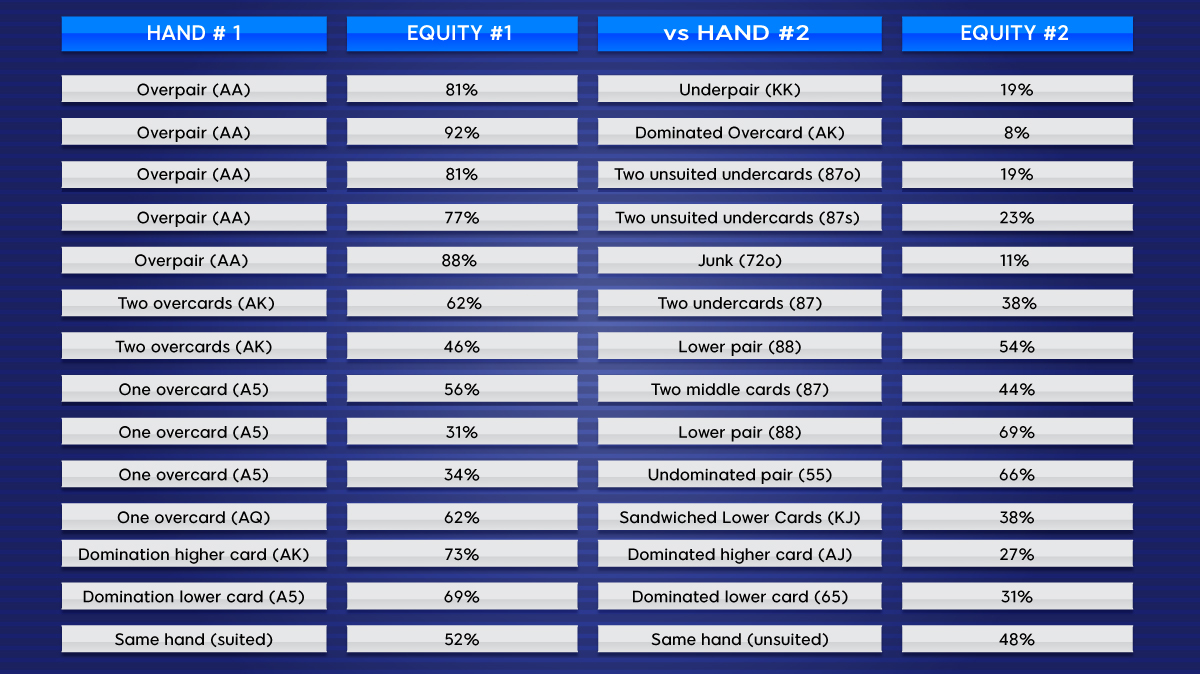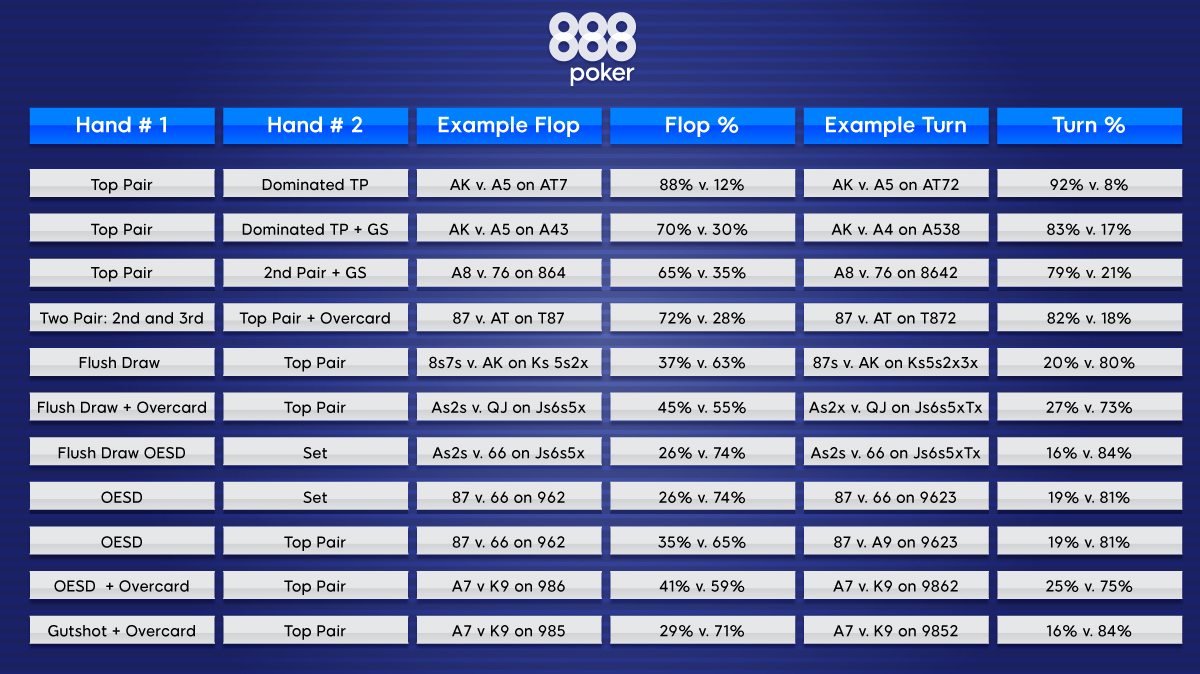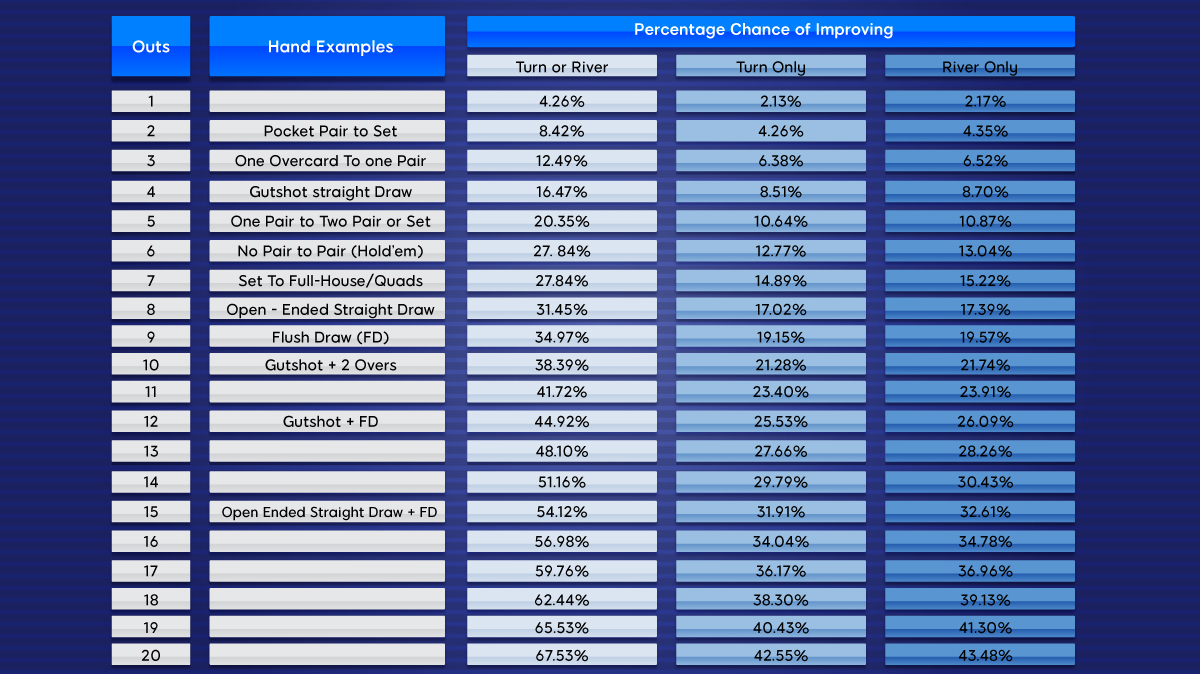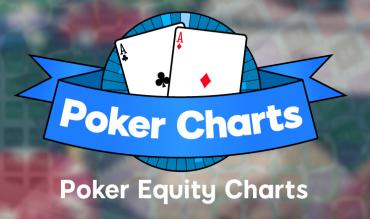Poker equity refers to the portion of the pot that should/could be yours according to the likelihood of winning the hand right now, whether it’s preflop, on the flop, on the turn, or on the river.
Put more straightforward, it usually refers to the percentage chance that you’ll win a hand at any given point.
This formula can be calculated in any of three formats:
- Hand vs Hand
- Hand vs Range
- Range vs Range
Table of Contents
- Equity Calculators and Software
- Poker Equity Chart: Common PREFLOP Scenarios
- Poker Equity Chart: Common POSTFLOP Scenarios
- The Mechanics of the Rule of 2 and 4
- The Rule of 2 and 4: Things to Remember
- Poker Odds Chart: Outs and Equities (Poker Equity Chart)
- What’s Up Next? Enter Pot Odds and Fold Equity
- In Conclusion
Equity Calculators and Software
Software and technology have advanced dramatically over the recent years to allow players to fast track their study and learn the ins and outs of poker strategy more quickly.
The following is a list of different programs and resources that can assist players with equity calculations:
- Equilab: This program was one of the pioneers of equity calculations. It is no longer being supported by its original developer, but a download of it can still be found through a Google search for it. This program is for Windows only.
- Tracking Software: Software like PokerTracker4 not only assist players with displaying stats of their own and their opponents but can also have its proprietary equity calculators.
- 888poker Odds Calculator: If you don’t have any poker software on your computer to assist you with your poker equity calculations, the 888poker website has a free equity calculator tool available for anyone to use.
- Flopzilla: This program brings so much more dimension to calculating equities versus your opponent in a hand. Being able to input your opponent’s range, and then see the breakdown of how many hands within their range fall under different categories of made poker hands (i.e. straight, set, one pair, draws, etc.) helps to give a dynamic array of information - which players can practice with and utilise during their off-table study. This program is for Windows only.
- PokerCruncher: If you like the sound of Flopzilla, but you’re a Mac user, fear not! There is indeed a program that can be found in the App Store that is quite similar, called PokerCruncher.
- Phone Apps: With too many to mention, there’s a vast range of phone apps available that can assist you with equity calculations when at or away from the table.
Poker Equity Chart: Common PREFLOP Scenarios
The chart below indicates the preflop equities of various matchups of poker hands when two players see a flop heads-up in Texas Hold’em poker.

Regarding preflop equities and the chart above, a few interesting things to note, include the following:
- No hand ever has 0% equity before a flop is dealt.
- Just because you may have decent pot odds to see a flop doesn’t mean you always should. Often it will be difficult to fully realise your hand’s equity when you’re out of position, such as when you’re in the small or big blind.
- Remember that while it’s good to memorise the above chart and know it like the back of your hand (for preflop hand vs hand equities), it’s essential to calculate your preflop equities against the RANGE of hands you might be facing, instead of against one particular holding. Once you understand how your hand does against your opponent’s range of hands, you can then proceed accordingly, relative to you and your opponent’s table position.
Poker Equity Chart: Common POSTFLOP Scenarios
The chart below indicates equities for common made-hand matchups once a flop has been dealt:

The Mechanics of the Rule of 2 and 4
When you have some sort of draw in poker, it’s essential to be able to calculate your approximate equity in the hand. The rule of 2 and 4 helps players accomplish this with relative ease and pretty decent precision.
NOTE: It’s crucial to understand that an “out” is a card that will improve the strength of your hand. For example, if you have 4 cards to a flush, then you will have 9 “outs” to hit your flush, as there are 13 cards of each suit in a standard deck of 52 playing cards.
This “rule” suggests that when you’re on the flop, you should multiply the number of outs you have by 4 to get a good approximation of your equity. (Note that this is factoring in the turn and river still to come.) The same can be done on the turn (with just the river remaining) by multiplying the number of outs that you have by 2.
The Rule of 2 and 4: Things to Remember
Your outs may not always be “clean” outs. For example, if you have an open-ended straight draw on a 2-flush board, it’s possible that 2 of your 8 outs to improve may simultaneously give your opponent a flush.
To account for this, it’s okay to lessen the number of outs you have at times by 0.5 outs or 1 out, and then calculate your equity accordingly.
As you’ll see from the chart below, the rule of 2 and 4 isn’t precisely accurate, of course, but does allow for you to gain a very good approximation of your hand’s equity.
Poker Odds Chart: Outs and Equities (Poker Equity Chart)

What’s Up Next? Enter Pot Odds and Fold Equity
After calculating your equity, it’s going to be essential to relate this to other factors in the hand to know how to proceed.
Two of these are “pot odds” and “fold equity”.
- Pot Odds: This refers to the price of a bet you must call to see the next street in a hand. If you have 25% equity, and your opponent makes a ½-pot bet, then you are getting precisely the right price to call to breakeven (as you’re getting 3 to 1 odds). If you realise that you’re not getting the right expressed odds, then maybe you can make a profitable call based on implied odds (the ability to win more money on future streets). Instead of calling, you might also choose to raise, if you think there’s a good chance your opponent will fold, which brings us to the next concept.
- Fold Equity: This concept is the equity you gain in a hand whenever you can get an opponent to fold, and the impact that this can have is massive! Imagine that you have 87s and your opponent has AJ. The flop comes 5-5-4. You bet, and your opponent calls with Ace-high and two overcards. The turn is a 9. You bet again (as a semi-bluff), and this time, your opponent folds and let’s go of his Ace-high. In this case, you were able to get a hand to fold that had a whopping 77% equity against you! Whenever you can get a better hand than yours to fold, this has a massive impact on your winrate and ability to build your stack. That said, don’t be reckless trying to bet too frequently in an attempt to ALWAYS push your opponents off their hands. But do realise that aggression (bets and raises) are going to help you become a winning player. The fold equity that you can gain, from making aggressive plays like this, crushes passive players who more frequently just check and call.
In Conclusion
By understanding the concept of poker equity and getting loads of practice, your off-table study will allow you to thrive when at the table. Complex mathematical calculations and fundamental winning concepts regarding equity calculations will become second nature, thus intuitively allowing you to have a better idea of how to proceed in a hand through any number of different scenarios.
Be sure to study the above charts until the information contained becomes ingrained, and you’ll have a firm grasp on hand vs range equity calculations.


